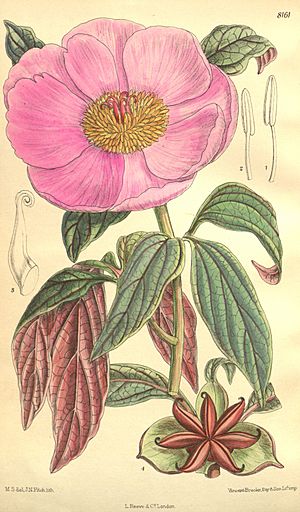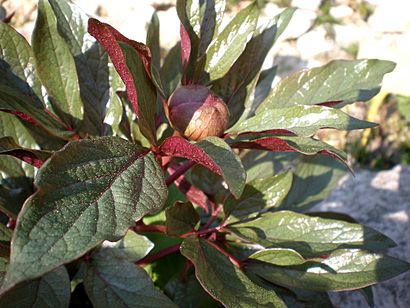Paeonia cambessedesii facts for kids
Quick facts for kids Paeonia cambessedesii |
|
|---|---|
 |
|
| Illustration, Botanical Magazine | |
| Scientific classification | |
| Genus: |
Paeonia
|
| Species: |
cambessedesii
|
| Synonyms | |
The Paeonia cambessedesii is a beautiful plant. It is a type of peony that grows back every year. This plant can reach about 45 centimeters (about 1.5 feet) tall. It has pretty pink flowers.
The stems and the veins on the leaves are reddish-purple. The top of the leaves turn a shiny bluish-green when they are fully grown. The lower leaves have no more than nine parts, called leaflets. This special peony only grows in the Balearic Islands. You can find it in parts of northeastern and northwestern Majorca. People sometimes call it the Balearic peony or Majorcan peony in English.
Contents
What the Balearic Peony Looks Like
The Balearic peony is a plant that grows in clumps. It's a perennial, meaning it lives for more than two years. It dies back in the autumn. Then, it grows new buds just under the soil for winter. It can grow to be 25–60 centimeters (10-24 inches) tall.
Its reddish-purple stem holds several leaves. These leaves grow one after another along the stem. The lowest leaves have nine tough, smooth leaflets. These leaflets are shaped like a spear or an upside-down egg. They have a pointy tip. The top of the leaf is bluish-green and shiny. The main veins are reddish-purple. The underside of the leaf is purple.
Each stem has one cup-shaped flower. The flower is 6–12 centimeters (2.5-5 inches) wide. It usually has eight (but can have 5-10) pale to purplish-pink petals. Some people say it smells like roses. Inside the flower, there are many purple threads with yellow tops. These yellow tops hold pollen. In the very middle of the flower are three to nine parts called carpels. They are purple at first. Each carpel has a thick stem with a reddish tip. These tips are ready to receive pollen before the pollen is ready. This helps prevent the flower from pollinating itself.
The carpels grow into dry fruits. These fruits are about 6 centimeters (2.5 inches) long. They open up along their length when ripe. Inside, the seeds are first red. Then they turn shiny black when they are fully ready.
Life Cycle of the Peony
In February, the plant's stalks start to pop out of the soil. They are a deep red color. This color comes from special pigments called anthocyanins. The dark color helps the young plant parts absorb sunlight. This keeps them from freezing early in the year.
By March, the stems unfold. The leaves and flower buds become easy to see. A few weeks later, the flowers may start to bloom. First, the tips in the center of the flower are ready for pollen. They stay this way for a few days. During this time, the pollen parts stay closed. This stops the flower from pollinating itself. Once the flower's center has been fertilized, the pollen parts open. Then, insects can pick up the pollen and carry it to other flowers.
In late August, the ripe fruits open up. The shiny black seeds can then spread. Seeds that were not fertilized look like soft, red grains. They have flat surfaces. New plants from these seeds usually only appear after several winters. Young peony plants first show up in early spring. Their high anthocyanin content protects them from frost.
How it's Different from Other Peonies
The Balearic peony is special. Its lower leaves always have nine whole leaflets. They are never more or cut. Also, all parts of this plant are completely smooth, without hairs. It usually has more carpels (3 to 8) per flower than other similar peonies. It almost always has reddish-purple stems and leaf undersides all year.
It is most similar to the Paeonia russoi from Corsica and Sardinia. But P. russoi is a different type of plant. Its leaves stay purple even when fully grown.
Naming the Peony
The Paeonia cambessedesii is a special plant. It has two sets of chromosomes. It is thought to be a hybrid plant. This means it came from two different parent plants. One parent is P. lactiflora. The other parent is most likely P. mairei. It's also possible that P. obovata played a role.
The plant was named to honor Jacques Cambessèdes. He was a French botanist. He collected plants in the Balearic Islands.
Where the Balearic Peony Lives
The Paeonia cambessedesii is a plant that only grows in the Balearic Islands. It used to be found on Mallorca, Menorca, and Cabrera. Now, it mostly grows in the mountains of northeastern Mallorca. You can find it in places like the Parc Natural de Llevant. It also grows in the northwest, on slopes of the Puig Major. It likes to grow on rocky limestone slopes or under limestone cliffs.
This peony grows with other plants like Aristolochia bianorum and Rosmarinus officinalis. Like all peonies, the Balearic peony is very poisonous. Animals that eat plants avoid it. Bees and other insects help pollinate its flowers.
Protecting the Balearic Peony
The area where the Balearic peony grows has become smaller. This is partly because of animals like wild goats eating the plants. But people also pick the flowers and dig up wild plants for their gardens.
Another problem is that its natural home is being damaged. New buildings and tourist areas are being built. This destroys the places where the peony can grow.
Growing the Balearic Peony
This plant is now a special item for plant collectors. It might not be very strong in cold weather. It also doesn't like too much water around its roots. So, it grows best in places with mild weather. It needs deep, well-draining soil that has a lot of lime. It also needs a warm, sunny, and protected spot. This plant has won an Award of Garden Merit from the Royal Horticultural Society.
How to Grow Seeds
To help the seeds sprout early, you can try a trick. Put them in a closed container with moist soil. Keep them in a refrigerator for three or four months. In early spring, you can plant the seeds outside. They usually sprout within a few weeks. If they don't sprout after the first cold treatment, you can try it again.
The small new plants of the Balearic peony have the same deep red color as their parents' shoots. This color helps protect them from frost. It might take four or five years before a young plant grows its first flower.
Other Uses
People used to say that the root of the Balearic peony could be used as a medicine. They believed it could help with epilepsy.
See also
 In Spanish: Paeonia cambessedesii para niños
In Spanish: Paeonia cambessedesii para niños



